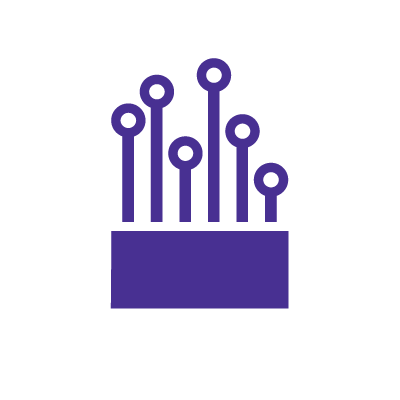Fiber Optic Vs Cable Internet: Differences Explained

The primary difference between fiber optic and cable internet is the medium used for data transmission. Fiber internet uses fiber optic wires made of ultra-thin glass strands that transmit data as light signals. In contrast, cable internet uses copper wires (coaxial cables) and electric signals to send data.
Check for service
Get internet service that delights
Astound is ranked among the best for overall satisfaction*. When it comes to download speed and quality, Astound more than delivers.

What is cable internet?
Cable internet transmits data via coaxial cables, the same technology television companies use.
This technology, which has proven to be effective for television companies, allows for broad coverage of cable internet services due to the extensive network of coaxial cable infrastructure.
Its inefficiency is due to its susceptibility to signal interference by other electronic devices, attenuation, (the loss of signal strength in networking cables or connections), over long distances and damage from unfavorable weather events.
Comparatively, cable internet is asymmetric, providing faster download speeds than upload speeds. It offers faster download speeds to prioritize the needs of typical internet users. Users tend to download more data (streaming videos, downloading images and surfing the web) than upload data (sending emails, uploading photos, or making video calls), requiring higher download speeds.
What is fiber internet?
Fiber internet uses fiber optic cables that transmit data faster as light pulses instead of electric signals. The technology uses ultra-thin glass strands, which are more efficient for transmitting data as they are less susceptible to signal interference due to temperature changes, contact with water, unfavorable weather events or long distances.
Fiber internet offers significantly faster upload and download speeds than other internet technologies. The high-speed performance enables users to seamlessly stream high-quality video and audio, download/upload large data files and engage in bandwidth-intensive activities like online gaming and video conferencing.
Fiber vs. cable comparison
While fiber and cable are high-speed internet connections, it’s essential to understand the nuanced differences between them. Let’s break down the key differences to help you make an informed decision when choosing an internet service.
Speeds
Both fiber and cable internet provide high speeds, with cable internet providing download speeds ranging from 100 Mbps to 1.5 Gig. While cable internet provides adequate download speeds for various online activities, it often emphasizes download speeds over upload speeds.
Comparatively, fiber internet stands out because of its exceedingly fast speeds. It provides faster upload and download speeds with speeds up to 5 Gig available in some areas. Some fiber internet plans even offer symmetrical speeds. Symmetrical speeds are equal upload and download speeds, which is advantageous for bandwidth-intensive activities like online gaming, video conferencing and large data transfers.
Find your speed
What speed do you need?
Maybe you just need the essentials—or maybe you need to unleash the ultimate internet speed. Explore your options to get the best experience for every device in your home.

Availability
The availability of fiber and cable internet largely varies depending on location. Cable internet relies on coaxial lines used for cable television, providing widespread availability in urban and suburban areas.
Fiber internet coverage is primarily available in select urban areas. However, its coverage is gradually expanding.
Installation
Cable internet installation is straightforward and user-friendly. If you have a cable TV connection, you can install it using an existing cable jack. Additionally, many cable internet ISPs offer self-installation kits, which contain instructions for connecting the modem/router to the existing coaxial cable outlet in the house. You then have to activate the service through the provider’s app.
On the other hand, fiber internet installation is more complex and generally requires professionals. It involves the installation of fiber optic cables directly to the home, which includes specialized equipment and expertise.
Some ISPs provide free fiber installation, especially if your home already has a fiber terminal onsite. However, other ISPs can charge between $50 and $100, depending on the complexity of the installation.
Reliability
The fiber optic cables transmit data as light pulses, resulting in minimal latency and less signal interference from electromagnetic interference and harsh environmental factors. Fiber internet can also maintain signal integrity over long distances, as the signals experience minimum attenuation and distortion.
In addition, fiber internet infrastructure is more resilient and less prone to physical damage and outages than cable internet. Fiber’s reliability and lower latency result in stable connections and faster response times for online activities like gaming and real-time communication.
In comparison, cable internet transmits data as electrical signals through copper coaxial cables, which can be susceptible to interference from nearby electronic devices or radio frequencies. The interference may disrupt data transmission, leading to higher latency levels and potential service outages.
How other types of internet compare
There are three other common types of internet technologies besides fiber and cable. These types include DSL, satellite and 5G home internet. Let’s look at how these internet technologies compare to fiber and cable.
5G home internet
5G home internet promises fast speeds, with providers offering up to 300 Mbps. However, 5G does not offer uniform speeds since various factors can influence its actual performance, including network congestion, proximity to 5G towers, physical obstacles and signal quality. These variables can cause delays and interference that limit data transmission, making your internet slower.
5G home internet providers offer plans starting from $55 which may include discounts depending on the carrier. However, some providers include data caps in their plans. If you exceed a predetermined amount of data, the provider may throttle your speeds and you may have to pay more to enjoy a faster connection.
Most service providers offer self-installation kits for 5G home internet, so you will need to set it up on your own. The kits include a quickstart guide, a 5G router, an antenna and a 5G SIM card. You also need the carrier’s app for activation and configuration.
5G home internet coverage is limited to select urban and suburban regions as its infrastructure is still in its early stages. It’s largely unavailable in rural areas.
Fiber-powered internet
Why Fiber Internet works better
Astound’s fiber-powered internet provides consistent speeds throughout the day versus 5G Home Internet which is prone to intermittency.

DSL
Digital Subscriber Line (DSL) is an internet technology that uses copper telephone lines to transmit data and traffic. While DSL provides speeds comparable to cable internet, it lacks the symmetrical or Gigabit speeds offered by fiber internet. DSL download speeds range from 1 Mbps to 7 Mbps, while the average upload speed is 1.5 Mbps.
DSL is widely accessible in urban and rural regions as it leverages the existing telephone infrastructure. Nonetheless, its speeds vary based on the distance between the user’s location and the central office, with users farther away from the central office experiencing slower speeds.
DSL internet can be self-installed by the user using their existing telephone wiring. It typically entails connecting a DSL modem to existing phone lines.
Satellite internet
Satellite internet is a good alternative for users in remote or rural areas to access the internet where other high-speed internet options like fiber, cable, 5G internet and DSL are unavailable.
Satellite internet is slower than fiber and cable, with speeds ranging from 25 Mbps to 150 Mbps. While satellite internet speeds have increased over time, they can be affected by factors like adverse weather conditions, higher latency and data caps imposed by the service providers.
Satellite internet plans are more expensive than fiber and cable options, ranging from $40 to $150 monthly. They usually also have restrictive data limits the providers impose and overage charges when you exceed the data caps. These charges increase costs for users with high data usage compared to unlimited data plans offered by fiber and cable internet.
Furthermore, satellite installation requires specialized equipment like a satellite dish antenna, a gateway router and an amplifier (optional). The FCC requires a professional satellite internet installation to meet particular guidelines on radiation exposure limits, follow environmental standards and help keep equipment warranties intact. However, you can install your own WiFi router instead of the gateway router to have a stronger WiFi signal in your home.
Astound ultra-fast internet gives everyone a better experience
Astound’s ultra-fast internet is a fiber-powered wired connection, providing more consistent performance and less vulnerability to signal interference than a wireless connection. The fiber-powered internet connection enables you to enjoy a seamless internet experience with faster speeds and a reliable connection.
Build your plan
Your perfect plan is just a click away
Get the speeds, WiFi, mobile and TV plans you need all at an affordable price. Bundle your services with Astound and see how much you can save.

Conclusion
The main differences between fiber and cable Internet are the data transmission medium, speeds and reliability.
Fiber uses fiber optic cables to transmit data as light pulses, offers symmetrical Gigabit+ speeds, reliability and can scale to accommodate a growing demand for data-intensive online activities. It can smoothly handle bandwidth-intensive activities like online gaming, large file transfers, video conferencing, cloud computing and VR.
On the other hand, cable internet transmits data as electric signals over coaxial cables. It provides high download speeds but often has slower upload speeds and is more susceptible to interference.
Astound offers a range of fiber-powered internet plans tailored to meet your needs. You can enjoy fast speeds and reliable connectivity that ensure a smooth internet experience for both work and entertainment.
*Internet speeds may vary & are not guaranteed. Certain equipment may be required to reach advertised speeds. DOCSIS 3.1 modem with 2.5GE physical LAN port is required for 1 Gigabit speeds and higher. See astound.com/yourspeed for why speeds may vary. To view Astound’s FCC Network Management Disclosure see astound.com/policies-disclaimers. Limited time offer, subject to change without notice. Advertised promotional price valid for duration of the stated promotional period from time of service activation. Regular rates apply after promotional period ends. Equipment not included and is extra. Modem required for Internet service. Enhanced Wi-Fi or Whole Home Wi-Fi (eero) not included and is add’l. Offer includes a monthly discount for enrollment in both automatic payments (autopay) & paperless billing (e-bill). Discount of $10 applies with automated bank account deduction or a discount of $5 applies with automated credit/debit card payment. Valid email address required. Must complete enrollment in autopay and e-bill within 30-days of placing the order. Without enrollment, the discount does not apply. Discount appears on bill within 3 bill cycles after enrolling. If either autopay or e-bill is canceled, services are changed, or the account is not in good standing, then the monthly discount will be discontinued. Offer valid only for new residential Astound customers or previous customers with an account in good standing who have not had Astound service within the last 60 days. Any add’l services, equipment, premium channels & other tiers of service are subject to an add’l charge & regular increases. A one-time activation fee of $14.99 (in addition to any installation fees) will be charged & is subject to change. Add’l fees apply for taxes & surcharges, and are subject to change. WA RESIDENTS: unless otherwise specified, price does not include a 2% Regulatory Administration Fee. For details about taxes, fees & surcharges visit astound.com/fees. No early termination fees apply in the event service is terminated in advance of the promotional end date. Customer is responsible for any accrued service charges in the event service is canceled. Subject to credit check. Not all services & speeds are available in all areas. A multi-product discount may be available to qualifying addresses with a subscription to mobile, TV, and 600 Mbps Internet or higher. Discounts will be reflected in your order cart at time of purchase, if available. Other restrictions may apply. All services are governed by the Astound Customer Terms & Conditions that can be found at astound.com/policies-disclaimers. © 2025 Radiate HoldCo, LLC d/b/a Astound Broadband. All rights reserved.
While we have made every attempt to ensure that the information contained in this site has been obtained from reliable sources, Astound is not responsible for any errors or omissions, or for the results obtained from the use of this information. All information in this site is provided “as is”, with no guarantee of completeness, accuracy, timeliness and without warranty of any kind, express or implied, including, but not limited to warranties of performance, merchantability and fitness for a particular purpose. Certain links in this site connect to other websites maintained by third parties over whom Astound has no control. Astound makes no representations as to the accuracy or any other aspect of information contained in other websites.
AT&T Internet Air, T-Mobile 5G home internet and Verizon 5G home internet details were pulled from their respective websites on December 5, 2023. *Internet speeds may vary & are not guaranteed. Certain equipment may be required to reach advertised speeds. Limited time offer, subject to change without notice. Advertised promotional pricing valid for 12 or 24 months from service start date, subject to change thereafter. Astound offers month-to-month service with base discounted introductory rate tiers. Prior to the end of any discounted rate tier, subscribers receive a notice informing them of the end of the discounted rate tier and providing information about the next discounted rate tier. Unless otherwise specified, 2-year price lock only available w/ promo internet pricing for speeds of 500 Mbps or greater. Additional fees apply for taxes and surcharges, and are subject to change. For details about fees & taxes visit astound.com/fees. Offer includes a monthly discount for enrollment in both automatic payments (autopay) & paperless billing (e-bill). Discount of $10 applies with automated bank account deduction or a discount of $5 applies with automated credit/debit card payment. Valid email address required. Must complete enrollment in autopay and e-bill within 30-days of placing the order. Without enrollment, the discount does not apply. Discount appears on bill within 3 bill cycles after enrolling. If either autopay or e-bill is canceled, services are changed, or the account is not in good standing, then the monthly discount will be discontinued.
**Source
eero Plus is available for an additional $9.99/month and requires subscription to whole home WiFi powered by eero.

















